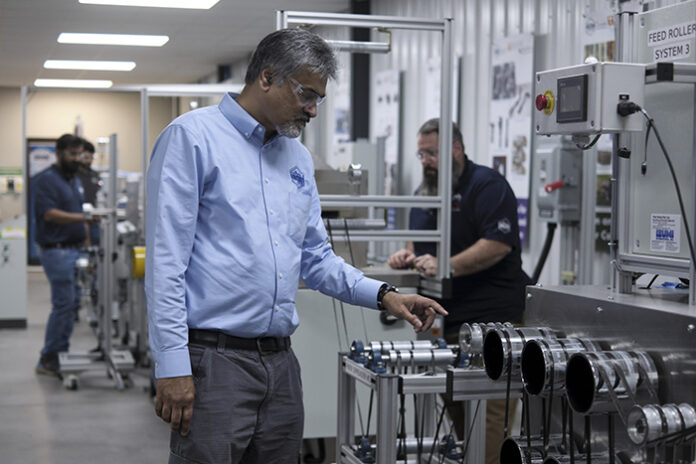The Composites Institute in partnership with Michelman, a global manufacturer of advanced materials, is pleased to announce the addition of a state-of-the-art fiber sizing line to the IACMI Collaboration Facility in Knoxville, Tenn. The 70-foot, modular system is designed to apply a variety of “fiber sizings,” a very thin chemical coating that serves multiple benefits in manufacturing. This process is an essential step in making composites lighter, stronger, and more versatile.
This unique equipment helps provide a faster path from research to commercialization, according to IACMI’s Chief Technology Officer Dr. Uday Vaidya, who serves as the University of Tennessee – Oak Ridge National Laboratory (UT-ORNL) Governor’s Chair in Advanced Composites Manufacturing.
“I am both grateful and excited to have this line commissioned to benefit multiple stakeholders in the composites ecosystem we’ve built between IACMI, ORNL, UT, and industry,” said Vaidya. “We’re not only researching and developing sustainable composites innovations. With the Michelman line, stakeholders can customize their constituent materials for a tailored fiber-matrix interface, which is key to the properties/performance of the composite.”
Ohio-based Michelman manufactures chemical solutions for agricultural and architectural coatings, digital printing, packaging, and advanced composites for automotive and aerospace. Michelman’s equipment enables hands-on training for next-generation engineers and is the culmination of many years of collaboration with IACMI.
“As a leading global supplier of sizing and surface treatments, Michelman is proud to support this collaboration between industry, government, and academia,” said Steve Bassetti, a Director of Global Marketing at Michelman. “With our purpose of Innovating a Sustainable Future, we are eager to invest in the success of the future workforce. By enabling students to apply classroom knowledge to real-world applications, we hope to accelerate students’ learning curves and fuel their passion to join the workforce within the composites industry. Who knows, perhaps some of these students will lead the way in developing the next generation of sustainable composites!”
A fiber sizing is a thin coating of a custom chemical formulation applied to the fiber to serve several functions. Benefits of sizings include protecting fibers from breaking during manufacturing and tailoring the properties of the surface to maximize the interfacial properties between the fiber and the polymer matrix, while also allowing the fiber format to be used or consumed in the multiple types of composite manufacturing processes.
Initial work is underway developing sizing solutions for standard and wide tow carbon fiber, but there are far more fibers and reinforcements to explore. “For example, we’re still scratching the surface on what we can do with natural fibers like hemp, flax, and coir to name a few,” said Vaidya. “Sky’s the limit for innovations in sizing development.”
This sizing line was custom-built by Izumi International, Inc. out of South Carolina. The line has unique features. The modularity of its design allows it to be used for fiber feed, fiber spread measurement, fiber damage assessment, conditioning in-line ovens/heaters, tension guides, wet baths, and a range of other custom features. One of its key benefits for stakeholders is being able to offer high-value applications by differentiating fibers and resin offerings based on custom sizing. Potential customers or industries benefiting from this line are broad, ranging from material suppliers, OEMS, Tiers, parts manufacturers, and small companies. The line is also ideal for continuous R&D for emerging chemistries, such as bio-based polymers and other feedstocks that provide more sustainable options.
Vaidya noted that sizing solutions for the aerospace market have typically focused on carbon fiber that’s compatible with thermoset epoxy and polyurethane resins. Now with more focus on sustainability and making composites more recyclable, there’s a lot of interest in fiber sizing options that are compatible with thermoplastic resins. Developing options for a broader family of fibers and resins can provide custom solutions for infrastructure, marine, wind, aerospace, defense, sporting, and healthcare sectors










